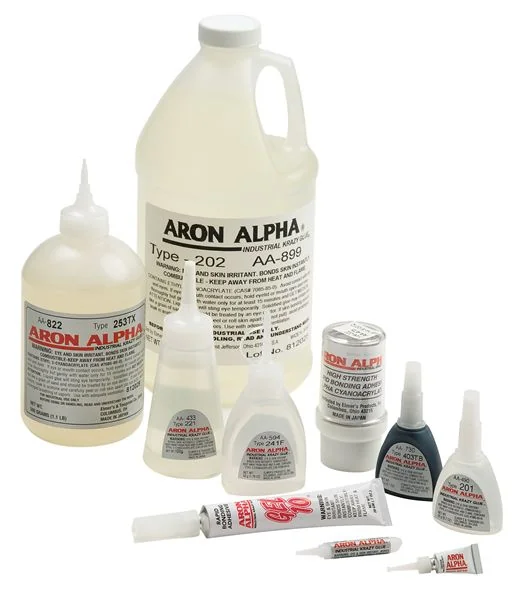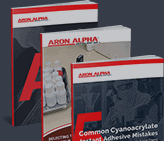Cyanoacrylate Instant Adhesives in Medical Device Applications
Click Here to jump directly to information about cyanoacrylates for COVID-19 and PPE purposes.
A Brief Overview of Cyanoacrylates
Cyanoacrylates – commonly referred to as CA glue, Krazy Glue®, or instant adhesives – are strong adhesives that bond quickly to surfaces in nearly any application. Cyanoacrylates bond instantly in the presence of water ions, contributed by the humidity present in surrounding conditions. Cyanoacrylate molecules form polymer chains through the process of anionic polymerization, resulting in instant bonds between the adhesive and applied surfaces, creating a thermal and heat-resistant bond.
Aron Alpha is one of the world’s initial developers of cyanoacrylate adhesives (we are a division of the Toagosei America, Inc. company; many are familiar with Krazy Glue®, another Toagosei brand), and today we offer a wide range of instant adhesives tailored to meet the needs of specific applications, including medical device manufacturing.
Types of Medical Device Adhesive Technologies
Depending on the application, medical device design engineers must generally choose between structural and non-structural adhesives.
Structural adhesives are used for load-bearing bonding applications, including bonding disposable medical devices and surgical and diagnostic equipment components together. Structural adhesives are typically composed of plastics such as urethane, acrylic, and epoxy materials valued for their tensile strength and durability. Cyanoacrylates fall under the category of structural adhesives, as they create a strong, solid bond that can withstand a great deal of tensile and shear force. The quick bonding capabilities of cyanoacrylates make them particularly valuable for medical applications that would previously have used less durable solvent adhesives or intrusive hardware such as screws and rivets.
Non-structural adhesives exhibit less strength and load-bearing capability than their structural counterparts. Rather than bonding through a chemical reaction such as polymerization, non-structural adhesives attach to surfaces physically and retain a level of flexibility. Common non-structural adhesives include contact adhesives, hot melts, aerosol sprays, and solvent-based adhesives. Non-structural adhesives can be tailored to work with a variety of materials, including metal, plastic, glass, fabric, and foam.
Advantages of Cyanoacrylates for Medical Device Applications
Cyanoacrylates are particularly useful for medical applications and offer a variety of advantages over other more traditional bonding methods. Benefits include:
- Variable Viscosity: Cyanoacrylates come in a range of viscosities to meet specific needs. Some applications require a thin liquid adhesive that can fill crevices and create a strong bond, while others require a gel-like consistency for enhanced control of the adhesive.
- High Fixture Speed: Cyanoacrylates are notable for the speed with which they bond and cure, or harden. Depending on the fundamental makeup of the adhesive, the curing time can be longer. The speed at which the adhesive cures can also be affected by localized humidity, material viscosity, bonding surface material, and load-bearing requirements.
- Shear Strength: Cyanoacrylates offer a range of materials that exhibit varying degrees of bond strength, depending on the material to which they are bonded. Long-term shear strength is also a necessary consideration. With the right cyanoacrylate, the adhesive bonds quickly to support various loads and will last an extended period of time.
- Moisture Resistance: Cyanoacrylates are available with rubber-toughened formulations that exhibit exceptional durability when frequently exposed to moisture. The ability of cyanoacrylates to resist moisture is largely based on the surface material to which it is bonded.
Which Medical Device Applications Are Cyanoacrylates Compatible With?
Medical-grade cyanoacrylates are a highly versatile adhesive option, and are designed with varying levels of viscosity and curing formulations. In addition, they must meet certain industry criteria, including biocompatibility, United States Pharmacopeia (USP) Class VI compliance, and ISO 10993 cytotoxicity guidelines.
Structural adhesives, including cyanoacrylates, are used for load-bearing medical equipment such as the bottoms of crutches, canes, walkers, cast boots, and surgical instruments. In addition, cyanoacrylates are widely used as an adhesive for medical equipment and devices that require a reliable bond, including:
- IV Sets
- Respirators
- Catheters
- Orthopedic Devices
- Hearing Aids
- Endoscopes
- Infusion Pumps
- Bonding Needles
- Wheelchairs
Medical Glue vs. Surgical Glue: What Are the Differences?
While both medical and surgical glues are cyanoacrylates, there are a few important distinctions between them. Most notably, their monomer makeup is different. The glue used in medical device manufacturing, categorized as medical glue, consists of ethyl cyanoacrylates or ECA. Ethyl cyanoacrylates are commonly used for one-time use devices like catheters and IVs, although they can be sanitized a second time to kill bacteria.
Surgical or skin glues typically use 2-octyl-cyanoacrylate. Dermabond is one of the most popular examples of this type of surgical glue. There are several reasons that octyl-based surgical cyanoacrylates are ideal as alternatives to sutures for surgical procedures and wound closures, including:
- They are less toxic.
- They are low odor.
- They do not burn skin on contact.
- They create a neater, more attractive wound closure than sutures.
How to Remove Medical Super Glue
Medical super glue and other instant adhesives are formulated to bind instantly. That works well when you need to close a wound or secure parts of a medical device, but what happens when you accidentally get the glue on a surface that you didn’t intend to bind? Below are some ways to clean up a super glue accident.
Skin
First, immerse the skin in warm, soapy water, using gentle pressure to separate the skin from the adhesive. If the warm water doesn’t help, try using acetone nail polish remover. With a cotton swab, apply the acetone to the adhesive until it dissolves. If the super glue is near the eyes or mucous membranes, try margarine, peanut butter, or vegetable oil to help break the bond.
Plastic
For plastic and vinyl, try soaking the object in non-ammonia detergent and water first. This method has the lowest chance of damaging the finish. Nitromethane is the next strongest option for a solvent that may still maintain the integrity of the plastic. The last option is to acetone; however, test in an inconspicuous spot before using it to avoid surface damage.
Metal
After cleaning the surface of the metal, press a cloth or cotton ball soaked in acetone against the adhesive. You could also try lighter fluid, denatured alcohol, or hydrogen peroxide as an alternative to acetone. For large deposits, try scraping with a putty knife or razor blade after softening with an all-purpose household cleaner.
Find out more about removing cyanoacrylate on various surfaces here.
Key Considerations When Choosing an Instant Adhesive for Medical Device Applications
In order to choose the correct adhesive for a given application, it is important to consider:
- Device design and intended application
- Bonding surface material and its characteristics
- Joint strength
- Operating environment and potential environmental stressors
- Required durability and shelf life
To learn more about choosing the right cyanoacrylates for your needs, visit these resources:
- Selecting the Right Instant Adhesive for Your Manufacturing Process
- How Cyanoacrylate Adhesives Work and Their Industrial Applications
- Comparing Cyanoacrylate, Epoxy, and Resin Adhesives
- 5 Common Cyanoacrylate Instant Adhesive Mistakes (And How to Avoid Them)
Medical Super Glues for COVID-19 PPE
Personal protective equipment, or PPE, is necessary to protect healthcare workers, first responders, lab technicians, and many other people on the frontlines of the pandemic. It includes masks, gloves, visors, gowns, goggles, and N95 respirators that meet the FDA’s criteria for protection against airborne or blood-borne bacteria and viruses. They are designed to protect the skin and mucous membranes of the nose, eyes, and mouth.
Medical grade cyanoacrylates, more commonly known as medical super glue, can be used for critical COVID-19 supplies, like PPE. Cyanoacrylates are excellent choices for plastic or rubber bonding needs. Medical glue provides a fast, secure, and sanitary method for constructing personal protective equipment. Cyanoacrylate glue medical adhesive can also be used for vital respiratory equipment and other medical devices.
Examples include:
- FFP2 filter masks
- Transparent eye and face shield
- Oxygen regulators, humidifiers, and flow control devices
- Breathing tubes and simple breathing masks
- Mechanical resuscitators
- Tracheal tubes
Medical Device Cyanoacrylates at Aron Alpha
At Aron Alpha, we are proud to provide top-quality industrial adhesives for medical customers around the world. In addition to our cyanoacrylate adhesive solutions, we offer custom formulations, lab services and testing, on-site engineering consultation, and prototype testing.
To learn more about our medical cyanoacrylate solutions, contact us today.









